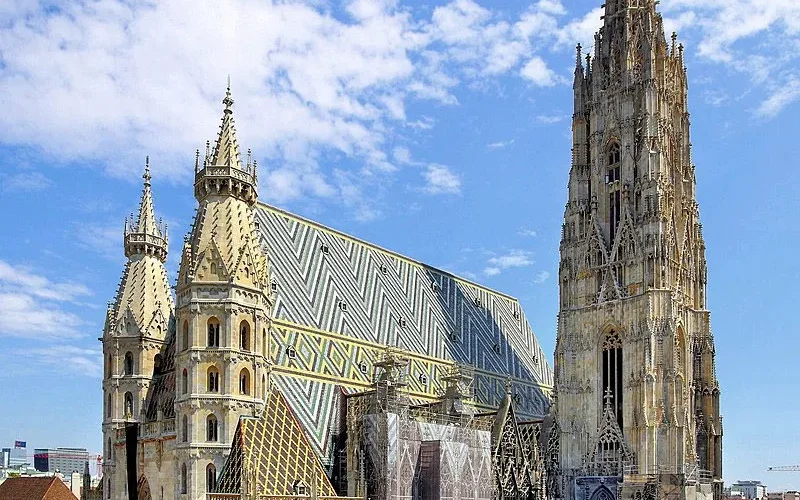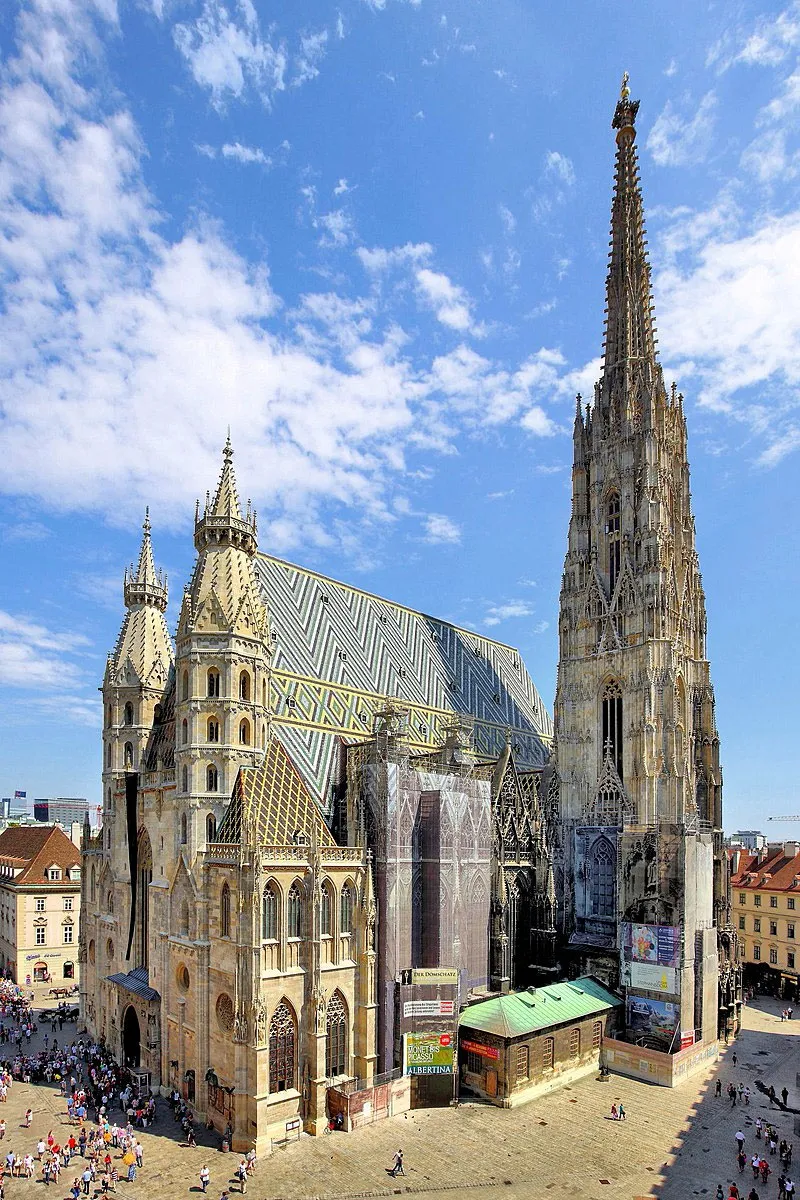
Introduction
St. Stephen’s Cathedral (Stephansdom) is not only the main Roman Catholic church in Vienna– and the seat of the city’s Archbishop – it’s also one of Austria’s most popular attractions, welcoming more than a million guests each year. With its 137-meter-high spire and richly decorated roof, it’s the city’s most important Gothic edifice and represents eight centuries of architectural history. All that remains of the original 13th-century structure are the massive gate and the Heathen Towers (Heidentürme). Next, came reconstruction in Gothic style in the 14th century and the completion of the choir and the Chapels of St. Eligius, St. Tirna, and St. Catherine, while the South Tower, the Nave, and the Chapel of St. Barbara were added in the 15th century. During WWII, the building experienced nearly complete destruction. Its reconstruction, from 1948 until 1962, proved to be a tremendous communal effort involving the whole of Austria, demonstrating the nation’s eagerness to restore this former symbol of the country’s illustrious past.
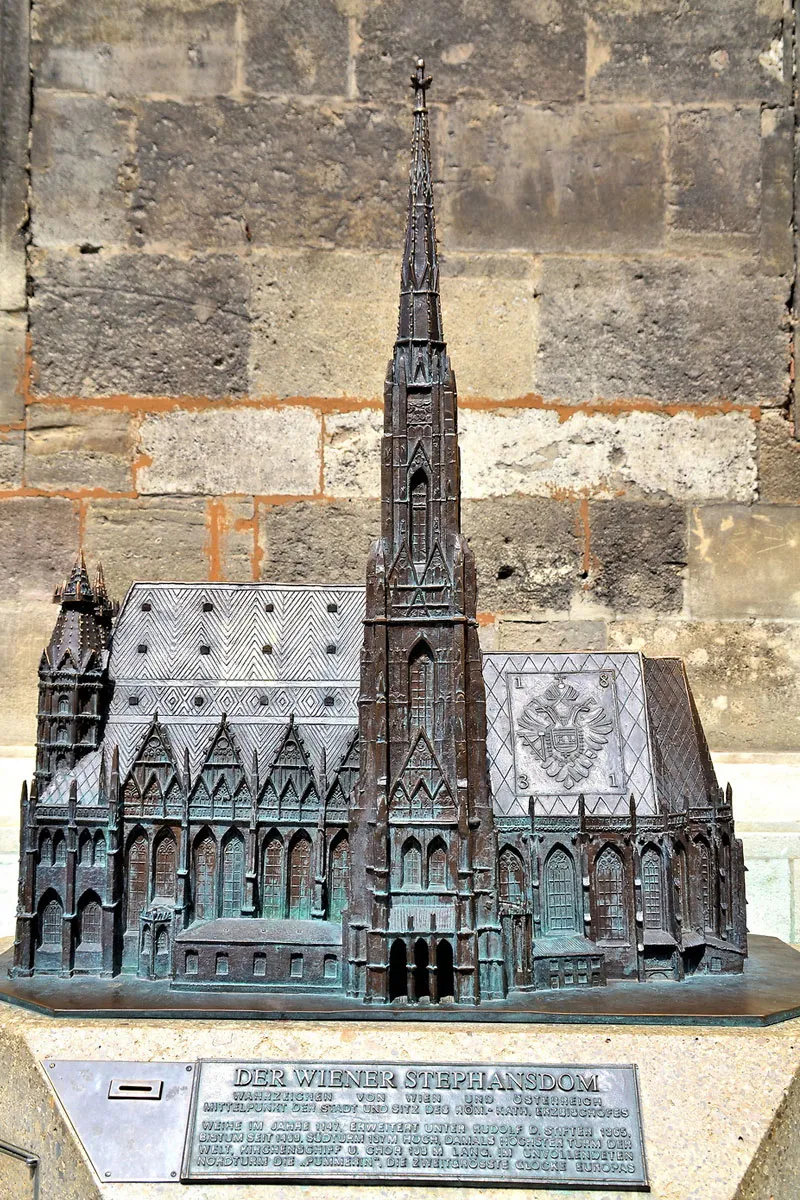
By the middle of the 12th century, Vienna had become an important centre of German civilization, and the four existing churches, including only one parish church, no longer met the town’s religious needs. In 1137, Bishop of Passau Reginmar and Margrave Leopold IV signed the Treaty of Mautern, which referred to Vienna as a civitas for the first time and transferred St. Peter’s Church to the Diocese of Passau. Under the treaty, Margrave Leopold IV also received from the bishop extended stretches of land beyond the city walls, with the notable exception of the territory allocated for the new parish church, which would eventually become St. Stephen’s Cathedral. Although previously believed built in an open field outside the city walls, the new parish church was in actuality likely built on an ancient cemetery dating to Ancient Roman times; excavations for a heating system in 2000 revealed graves 2.5 metres (8.2 ft) below the surface, which were carbon-dated to the 4th century. This discovery suggests that an even older religious building on this site predated the St. Rupert’s Church, which is considered the oldest church in Vienna.
Growth of the cathedral, showing the Roman towers and Giant’s Door from the burned first church (1137), the Romanesque second church (1263), the Gothic Albertine Choir (1340), and the Duke Rudolf IV additions (1359), which removed the second church, leaving Stephansdom as it appears today.
Founded in 1137 following the Treaty of Mautern, the partially constructed Romanesque church was solemnly dedicated in 1147 to Saint Stephen in the presence of Conrad III of Germany, Bishop Otto of Freising, and other German nobles who were about to embark on the Second Crusade. Although the first structure was completed in 1160, major reconstruction and expansion lasted until 1511, and repair and restoration projects continue to the present day. From 1230 to 1245, the initial Romanesque structure was extended westward; the present-day west wall and Romanesque towers date from this period. In 1258, however, a great fire destroyed much of the original building, and a larger replacement structure, also Romanesque in style and reusing the two towers, was constructed over the ruins of the old church and consecrated 23 April 1263. The anniversary of this second consecration is commemorated each year by a rare ringing of the Pummerin bell for three minutes in the evening.
In 1304, King Albert I ordered a Gothic three-nave choir to be constructed east of the church, wide enough to meet the tips of the old transepts. Under his son Duke Albert II, work continued on the Albertine choir, which was consecrated in 1340 on the 77th anniversary of the previous consecration. The middle nave is largely dedicated to St. Stephen and All Saints, while the north and south nave, are dedicated to St. Mary and the Apostles respectively. Duke Rudolf IV, the Founder, Albert II’s son, expanded the choir again to increase the religious clout of Vienna. On 7 April 1359, Rudolf IV laid the cornerstone for a westward Gothic extension of the Albertine choir in the vicinity of the present south tower. This expansion would eventually encapsulate the entirety of the old church, and in 1430, the edifice of the old church was removed from within as work progressed on the new cathedral. The south tower was completed in 1433, and vaulting of the nave took place from 1446 to 1474. The foundation for a north tower was laid in 1450, and construction began under master Lorenz Spenning, but its construction was abandoned when major work on the cathedral ceased in 1511. Watercolor by Jakob Alt, 1847
In 1365, just six years after beginning the Gothic extension of the Albertine choir, Rudolf IV disregarded St. Stephen’s status as a mere parish church and presumptuously established a chapter of canons befitting a large cathedral. This move was only the first step in fulfilling Vienna’s long-held desire to obtain its own diocese; in 1469, Emperor Frederick III prevailed upon Pope Paul II to grant Vienna its own bishop, to be appointed by the emperor. Despite long-standing resistance by the Bishops of Passau, who did not wish to lose control of the area, the Diocese of Vienna was canonically established on 18 January 1469, with St. Stephen’s Cathedral as its mother church. In 1722 during the reign of Karl VI, Pope Innocent XIII elevated the see to an archbishopric.
During World War II, the cathedral was saved from intentional destruction at the hands of retreating German forces when Wehrmacht Captain Gerhard Klinkicht disregarded orders from the city commandant, “Sepp” Dietrich, to “fire a hundred shells and reduce it to rubble”. On 12 April 1945, civilian looters lit fires in nearby shops as Soviet Army troops entered the city. The winds carried the fire to the cathedral, where it severely damaged the roof, causing it to collapse. Fortunately, protective brick shells built around the pulpit, Frederick III’s tomb, and other treasures, minimized damage to the most valuable artworks. However, the Rollinger choir stalls, carved in 1487, could not be saved. Reconstruction began immediately after the war, with a limited reopening 12 December 1948 and a full reopening 23 April 1952.
Architecture of St. Stephen's Cathedral
Friedrich III’s Raised Sepulchre in the south choir. Made of red marble and including a larger-than-life-size statue of the Emperor surrounded by coats of arms, the design is by Dutch artist Niclas Gerhaert van Leyden (1467-1513) who also made the top of this Gothic grave. The 15th-century Late Gothic Canopy over the Leopold Altar is also worth seeing, as is the Pötscher Madonna, an object of veneration in Austria and Hungary since the Battle of Zenta in 1697 when, according to legend, tears streamed from the eyes of the Madonna for a fortnight at the time of the battle against the Turks. In the foyer the public is met by a light, open space with a large, undulating oakwood wall. Behind this wall are the opera house’s three performance halls, with the Main House forming the heart of the building. Acoustic requirements determined the interior design of the Main House, and the combination of timbre and tonal possibilities and the dark, golden woodwork can be said to have transformed the Main House into a singularly outsized wooden instrument. Oslo Opera House also has two smaller stages – the Second House and the Studio. Advanced theatre technology, specially built workshops, and rehearsal rooms for dance, song, orchestra and chorus make Oslo Opera House a modern, fully integrated performance venue. Every step in the process of creating performance art can be completed here.
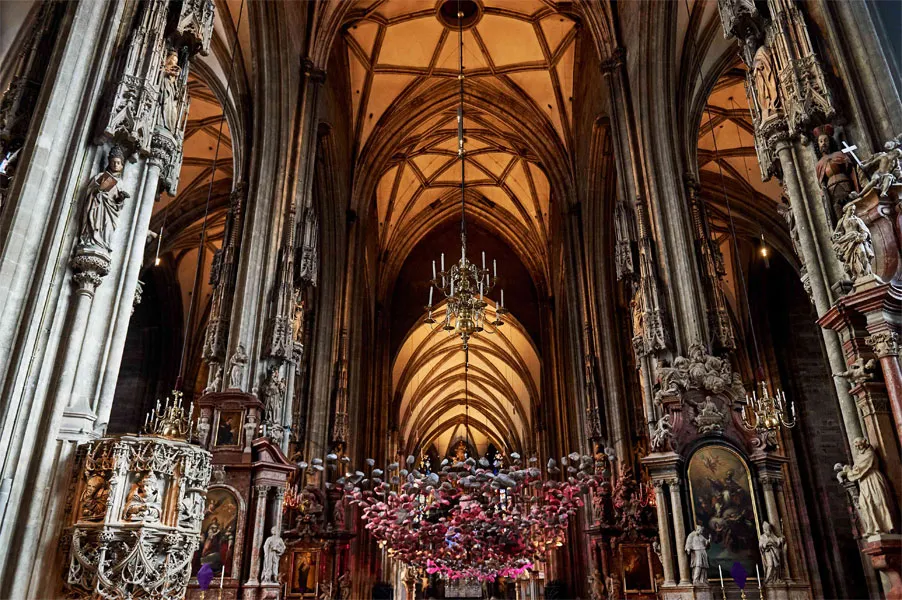
Altars
The main part of the church contains 18 altars, with more in the various chapels. The High Altar (HA) and the Wiener Neustadt Altar (German: Wiener Neustädter Altar) (WNA) are the most famous. The first focal point of any visitor is the distant High Altar, built over seven years from 1641 to 1647 as part of the first refurbishment of the cathedral in the baroque style. The altar was built by Tobias Pock at the direction of Vienna’s Bishop Philipp Friedrich Graf Breuner with marble from Poland, Styria and Tyrol. The High Altar represents the stoning of the church’s patron St. Stephen. It is framed by figures of patron saints from the surrounding areas – Saints Leopold, Florian, Sebastian and Rochus – and surmounted with a statue of St. Mary which draws the beholder’s eye to a glimpse of heaven where Christ waits for Stephen (the first martyr) to ascend from below.
Wiener Neustädter Altar
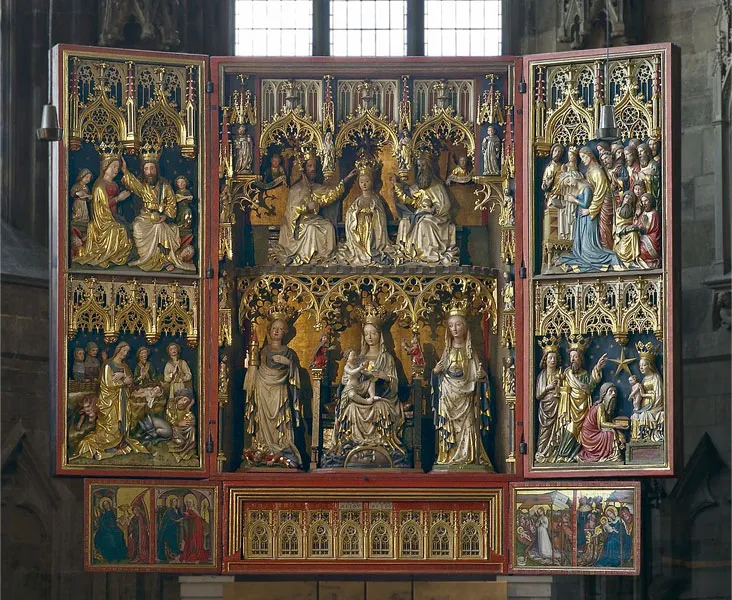
The Wiener Neustädter Altar at the head of the north nave was ordered in 1447 by Emperor Frederick III, whose tomb is located in the opposite direction. On the predella is his famous A.E.I.O.U. device. Frederick ordered it for the Cistercian Viktring Abbey (near Klagenfurt) where it remained until the abbey was closed in 1786 as part of Emperor Joseph II’s anti-clerical reforms. It was then sent to the Cistercian monastery of St. Bernard of Clairvaux (founded by Emperor Frederick III) in the city of Wiener Neustadt, and finally sold in 1885 to St. Stephen’s Cathedral when the Wiener Neustadt monastery was closed after merging with Heiligenkreuz Abbey.
The Wiener Neustädter Altar is composed of two triptychs, the upper being four times taller than the lower one. When the lower panels are opened, the Gothic grate of the former reliquary depot above the altar is revealed. On weekdays, the four panels are closed and display a drab painted scene involving 72 saints. On Sundays, the panels are opened showing gilded wooden figures depicting events in the life of the Virgin Mary. Restoration began on its 100th anniversary, in 1985 and took 20 years, 10 art restorers, 40,000 man-hours, and €1.3 million to complete, primarily because its large surface area of 100 square metres (1,100 sq ft). The main part of the church contains 18 altars, with more in the various chapels. The High Altar (HA) and the Wiener Neustadt Altar (German: Wiener Neustädter Altar) (WNA) are the most famous.
The first focal point of any visitor is the distant High Altar, built over seven years from 1641 to 1647 as part of the first refurbishment of the cathedral in the baroque style. The altar was built by Tobias Pock at the direction of Vienna’s Bishop Philipp Friedrich Graf Breuner with marble from Poland, Styria and Tyrol. The High Altar represents the stoning of the church’s patron St. Stephen. It is framed by figures of patron saints from the surrounding areas – Saints Leopold, Florian, Sebastian and Rochus – and surmounted with a statue of St. Mary which draws the beholder’s eye to a glimpse of heaven where Christ waits for Stephen (the first martyr) to ascend from below.
The Chapel
The first of many chapels you’ll see is the Tirna Chapel, built in 1359 and the burial place of Prince Eugene, conqueror of the Turks. In addition to the 15th-century Crucifix above the altar, take a peek at the beard of Christ: it’s made of human hair and, according to legend, is still growing. The most notable features of the Catherine Chapel are its marble font from 1481, and the reliefs on the 14-sided basin depicting Christ, John the Baptist, and the Twelve Apostles, while on its plinth are the Four Evangelists. Also worth visiting is the Eligius Chapel, or Dukes’ Chapel, with its important 14th-century statues.
The Tower
St. Stephen’s is particularly famous for its majestic towers, which have dominated Vienna’s skyline for centuries. The tallest of these is the Steffl, as the Viennese call the South Tower. Begun in 1356, it stands 137-meters high and is considered the most beautiful German Gothic tower in Europe thanks to features such as the statues below the richly ornamented canopies on the second floor. While it’s a tough climb up the 343 steps to the Watch Room, it’s worth it for the spectacular views over the city. Also worth visiting is the Cathedral’s North Tower, home to the massive Pummerin Bell, rung only on special occasions such as New Year’s Eve (a fast lift takes visitors to a viewing platform).
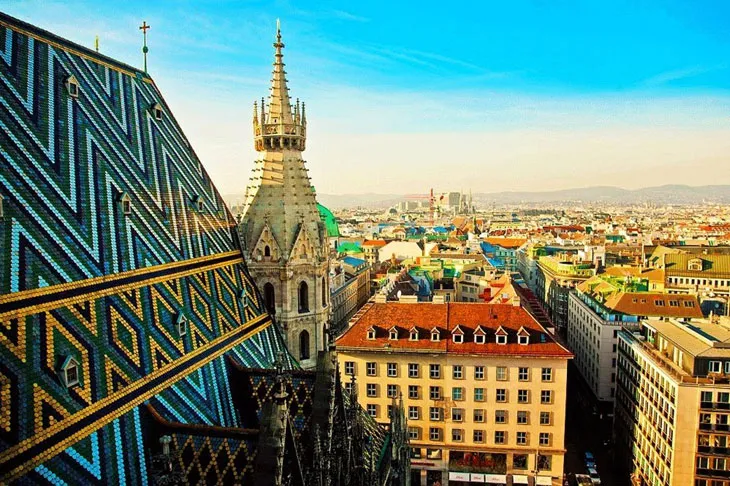
The Catacombs and The Cathedral Treasure
The entrance to the must-see Catacombs is through a chamber under the North Tower of St. Stephen’s. Accessible only as part of a guided tour, they extend from the Cathedral Choir all the way to Stephansplatz and include the bones of around 10,000 Viennese citizens stacked up in tiers (this part is not open to the public). Constructed at the end of the 14th-century to house remains from the area’s overcrowded graveyards, the Catacombs were closed in 1783. Today, the major attraction is the Ducal Vault, which Rudolf IV had constructed for the Habsburgs in 1363. Also worth seeing is the Cathedral Treasure. In the West Gallery, this fascinating exhibit houses many of the church’s most important – and valuable -objects.
Balassi Mass
Since 2008, the two sabres of the Balint Balassi Memorial Sword Award, founded by Pal Molnar, have been blessed during a Balassi Mass held a few days before the award ceremony. On 25 January 2013, in the presence of some three hundred Hungarians, Bishop Laszlo Kiss-Rigo blessed the two swords during a Mass celebrated in the cathedral.
Annual Feast Day
Feast day: 26 December
The annual feast day of Sanctuary of Pellevoisin, France is celebrated on February 14 each year.
Mass Timing
The Cathedral is open to the public during the following opening hours:
- Monday to Saturday: 6 am – 10 pm
- Sundays and Public Holidays: 7 am – 10 pm
Church services take place daily and have slightly different schedules in the Summer than during the rest of the year. Details can be found here. At any time of the year there is a mass read in English on Saturdays at 7 pm.
Church Visiting Hours
- Monday to Saturday 9.00 am – 11.30 am and 1.00 pm to 4.30 pm
- Sundays and public holidays from 1.00 pm to 4.30 pm
Contact Info
Vienna,
Stephansplatz 3, 1010 Wien,
Austria.
Phone No.
Phone: +43 1 515523530
Accomodations
Connectivities
Airway
The nearest airport to the Church of St. Stephen’s Cathedral, Vienna
Airport which is just 30 min (20.5 km) via away from the basilica.
Railway
The nearest railway to the Church of Sanctuary of Pellevoisin Lucay-le-Mâle Champ de Foire which is just 14 min (17.8 km) via away from the basilica.

